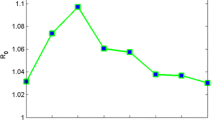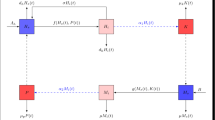Abstract
National Bureau of Statistics of China reports that the incidence of schistosomiasis has been increasing in recent years. To study dynamic behaviors of schistosomiasis transmission, based on practical experience of staff in Anhui Institute of Schistosomiasis, a mathematical schistosomiasis model with reinfection of recovered people is established in this paper. Metzler matrix theory and center manifold theorem are used to analyze stability of equilibria. Parameter estimation has been performed by combining model and monitoring data. It is found that the basic reproduction number is different every year. The most concern of Institute of Schistosomiasis is whether or when to kill snails every year. To answer this question, threshold value of snail density can be obtained. Once the snail density exceeds the threshold, the staff will need to kill snails. To find the best control measures, sensitivity analysis is used to find out sensitive parameters, and then control measures can be obtained by optimization control measures. The results show that combination of spraying molluscicide, publicity and education, improving the health facilities, and large-scale treatment of patient groups have the best effect. In additional, it is found that the number of patients does not change much when the reinfection rate of recovered people is very small. However, when the reinfection rate is slightly larger, the number of patients will suddenly increase to a large value.




Similar content being viewed by others
References
Castillo-Chavez C, Song BJ (2004) Dynamical models of tuberculosis and their applications. Math Biosci Eng 1:361–404
Diekmann O, Heesterbeek JAP, Metz JAJ (1990) On the definition and the computation of the basic reproduction ratio R0 in models for infectious diseases in heterogeneous populations. J Math Biol 28:365–382
Feng ZL, Li CC, Milner FA (2002) Schistosomiasis models with density dependence and age of infection in snail dynamics. Math Biosci 177:271–286
Feng ZL, Eppert A, Milner FA, Minchella DJ (2004) Estimation of parameters governing the transmission dynamics of schistosomes. Appl Math Lett 17:1105–1112
Feng ZL, Li CC, Milner FA (2005) Schistosomiasis models with two migrating human groups. Math Comput Model 41:1213–1230
Fleming WH, Rishe RW (2012) Deterministic and stochastic optimal control. Springer, New York
Gao SJ, He YY, Liu YJ (2013) Field transmission intensity of Schistosoma japonicum measured by basic reproduction ratio from modified Barbourars model. Parasites Vectors 6:1–10
Kamgang JC, Sallet G (2008) Computation of threshold conditions for epidemiological models and global stability of the disease-free equilibrium (DFE). Math Biosci 213:1–12
Mao SB (1990) Biology of schistosome and control of schistosomiasis. People’s Health Press, Beijing (in Chinese)
Ni Y, Zhang ZJ, Peng WX (2006) Epidemiological characteristics of acute schistosomiasis from 2001 to 2005 in Guichi District. J Trop Dis Parasitol 4:105–106
Qi LX, Cui JA, Gao Y, Zhu HP (2012) Modeling the schistosomiasis on the islets in Nanjing. Int J Biomath 5:1–17
Qi LX, Cui JA (2014) Mathematical model of Schistosomiasis under flood in Anhui province. Abstr Appl Anal 2014:1–7
Sun GZ, Du XN (2003) Higher mathematics. Anhui University Press, Hefei
van den Driessche P, Watmough J (2002) Reproduction numbers and sub-threshold endemic equilibria for compartmental models of disease transmission. Math Biosci 180:29–48
Wang YH, Zhang ZJ (2008) Analysis of endemic situation of schistosomiasis in Guichi District of Chizhou City, Anhui Province from 2000 to 2006. Chin J Schisto Conrol 20:89–92
WHO (2016) Schistosomiasis, http://www.who.int/mediacentre/factsheets/fs115/en/. Accessed 20 Feb 2018
Xu HJ, Fu XL (2006) Immunopathological observations on the infection of Schistosoma japonicum induced by different manners. Chin J Zoonoses 22:647–650
Zou L, Ruan SG (2015) Schistosomiasis transmission and control in China. Acta Trop 143:51–57
Acknowledgements
This research is supported by National Natural Science Foundation of China (11401002) and Natural Science Fund for Colleges and Universities in Anhui Province (KJ2018A0029).
Author information
Authors and Affiliations
Corresponding author
Rights and permissions
About this article
Cite this article
Qi, L., Xue, M., Cui, Ja. et al. Schistosomiasis Transmission Model and its Control in Anhui Province. Bull Math Biol 80, 2435–2451 (2018). https://doi.org/10.1007/s11538-018-0474-7
Received:
Accepted:
Published:
Issue Date:
DOI: https://doi.org/10.1007/s11538-018-0474-7




